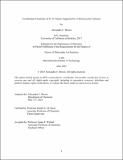| dc.contributor.advisor | Suess, Daniel L. M. | |
| dc.contributor.author | Brown, Alexandra C. | |
| dc.date.accessioned | 2023-09-13T18:06:50Z | |
| dc.date.available | 2023-09-13T18:06:50Z | |
| dc.date.issued | 2023-06 | |
| dc.date.submitted | 2023-09-05T20:08:39.365Z | |
| dc.identifier.uri | https://hdl.handle.net/1721.1/152126 | |
| dc.description.abstract | Iron–sulfur clusters are ubiquitous in Nature and carry out some of the most challenging multielectron redox reactions in the biosphere while utilizing three primary building blocks: Fe²⁺, Fe³⁺, and S²⁻. Studying synthetic Fe–S clusters aids in understanding the underlying properties of Fe–S clusters that enable this reactivity by providing Fe–S clusters with unusual coordination spheres that are amenable to multiple modes of structural and spectroscopic characterization. Synthetic Fe–S cluster chemistry is hindered by poor control over the coordination sphere of metalloclusters as compared to mononuclear complexes: the large size of metalloclusters means changing the ligand at one metal site often has little effect on the neighboring sites. Here, we introduce a strategy based on the remote steric profiles of ligands on adjacent metal sites (here, monodentate N-heterocyclic carbenes), to obtain [Fe₄S₄] clusters for which subsequent reactivity can be localized to a single Fe site. That is, the steric bulk of di-aryl NHC ligands enables isolation of [Fe₄S₄] clusters in which three of the Fe centers are coordinated to NHCs and that further ligand exchange reactivity is localized to the unique Fe site. Following the establishment of this site-differentiation strategy, we demonstrate its application to several outstanding problems in Fe–S cluster chemistry. First, we demonstrate that Fe–S clusters are able to bind and activate π-acidic ligands like CO, resolving the disconnection between the reactivity of Fe–S clusters and the typical reactivity of high-spin, mid-valent Fe centers by showing that Fe–S clusters can access low-valent states which have sufficient π-basicity to activate CO. We expand this chemistry to electronically tunable aryl isocyanide ligands and demonstrate that Fe–S clusters can access multiple electron configurations with varying capacity for π-backbonding, highlighting the importance of Fe–Fe interactions within an Fe–S cluster for tuning the Fe valences and binding π-acidic ligands. We next synthesize an [Fe₄S₄] cluster supported by a bulkier NHC ligand and demonstrate that it can be reduced to reveal a three-coordinate Fe site with no apparent affinity for N₂. Driven by the lack of N₂ affinity in the [Fe₄S₄] cluster—in contrast to [MoFe₃S₄] clusters—we next explore binding of CO at [MoFe₃S₄] clusters to understand the effects of Mo incorporation on intracluster bonding; comparisons between these clusters and analogous [Fe₄S₄]–CO clusters reveals that the [MoFe₃S₄]–CO clusters exhibit attenuated changes to their structures and spectra over redox events. This suggests that Mo may increase the covalency within the cluster, potentially making access to these low valent states more facile. Lastly, we introduce three studies aimed at modelling biological Fe–S cluster chemistry: revealing reversible homolytic Fe–C bond cleavage at Fe–S clusters to release alkyl radicals and modeling its effects on the selectivity of radical reactions, synthesizing alkene- and alkyne-bound Fe–S clusters, and abstracting Fe²⁺ from [Fe₄S₄] clusters to access the first synthetic [Fe₃S₄]⁺ clusters. | |
| dc.publisher | Massachusetts Institute of Technology | |
| dc.rights | In Copyright - Educational Use Permitted | |
| dc.rights | Copyright retained by author(s) | |
| dc.rights.uri | https://rightsstatements.org/page/InC-EDU/1.0/ | |
| dc.title | Coordination Chemistry of Fe–S Clusters Supported by N-Heterocyclic Carbenes | |
| dc.type | Thesis | |
| dc.description.degree | Ph.D. | |
| dc.contributor.department | Massachusetts Institute of Technology. Department of Chemistry | |
| dc.identifier.orcid | https://orcid.org/0000-0002-2410-9217 | |
| mit.thesis.degree | Doctoral | |
| thesis.degree.name | Doctor of Philosophy | |
